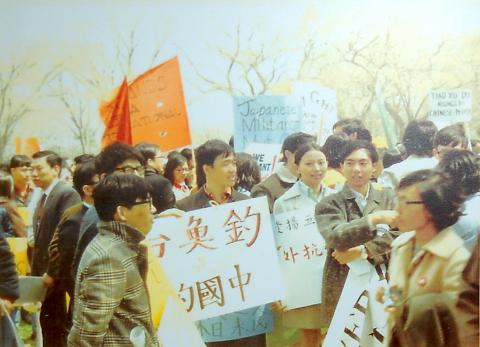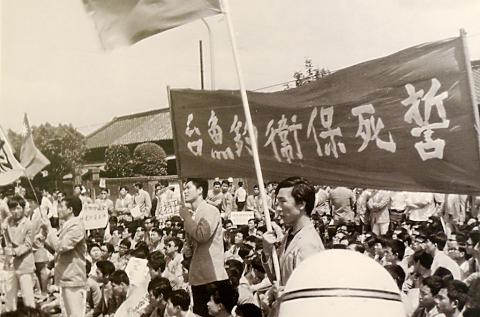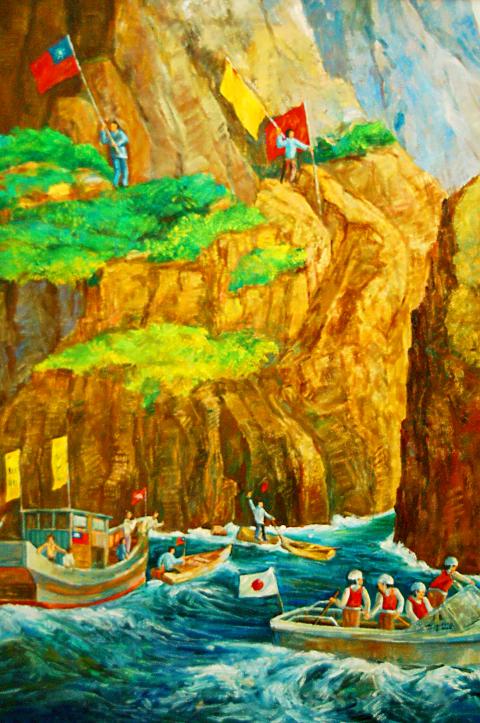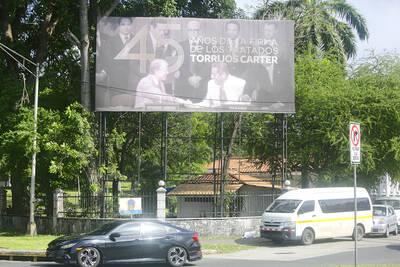April 8 to April 14
It began on April 12, 1971 with the appearance of a poster that read “Diaoyutai is ours! (釣魚台是我們的)” on the National Taiwan University (NTU) campus. Stemming from a territorial dispute between Japan, Taiwan and China over the Diaoyutai Islands (釣魚台), student movements exploded in both the US and Taiwan that year. The territorial dispute was never settled, and remains a contentious issue among the three countries today.
What’s intriguing about the baodiao (保釣, “protecting the Diaoyutais”) student movement is that students from Taiwan and Hong Kong studying in the US took the lead months before anything happened in Taiwan, organizing two well-attended marches in January across seven American cities. A second wave of protests in San Francisco and Washington DC took place on April 9 and April 10, just before the poster appeared at NTU.

Photo: Chen Yi-shan, Taipei TImes
On April 13, a 10-meter long banner was hung outside the now-demolished agricultural economics building that borrowed a slogan from the 1919 May Fourth Movement (五四運動) that initially broke out to prevent Shandong Province from being handed over to Japan: “One can conquer China’s territory, but we cannot just give it away; one can kill the people of China, but we will not bow our heads,” the banner read.
However, due to martial law the student movement in Taiwan faced considerable interference from the government and schools — even when their actions were in the name of patriotism and the national interest.
DISPUTED ROCKS

Photo courtesy of Gallery of National Taiwan University History
The Diaoyutai — known as the Diaoyu Islands in China and Senkakus in Japan — are a group of uninhabited islands 186km northeast of Keelung. The US controlled the islands after World War II along with the Ryukyu Islands, and in the late 1960s the US were preparing to return the Ryukyus to Japan.
Nobody seemed to care about the insignificant Diaoyutai rocks until the UN Economic and Social Commission for Asia and the Pacific in 1968 revealed the possibility of petroleum reserves in nearby waters. Taiwan claimed the islands in July 1969, which Japan officially rejected the following year.
Japan argued that it had already occupied the islands in January 1895 before the signing of the Treaty of Shimonoseki in which the Qing Empire ceded Taiwan and Penghu to Japan. Thus, it should not be included in the territories that the Republic of China (ROC) government took ownership of after World War II. Furthermore, neither Taiwan nor China made any claim toward the islands until the discovery of oil.

Photo: Chang Jui-chen, Taipei Times
The ROC government on Taiwan in turn argued that several Qing Empire annals showed the islands as part of it its territory. There was also evidence that in 1884 the Japanese government denied a request from Okinawa to officially incorporate the rocks into its jurisdiction because they didn’t want to anger China.
While the ROC claimed that Japan never formally annexed the islands, Japan argues that it did so in January 1895. The ROC also believed that they should have recieved the islands along with Taiwan and Penghu after World War II. Geologically, they argued that the rocks were connected to Taiwan rather than Okinawa.
On Sept. 2, 1970, four China Times (中國時報) journalists traveled to the islands, planting a ROC flag and painting “Long Live President Chiang [Kai-shek (蔣介石)]” on a nearby rock. Okinawan police arrived and removed the flag two weeks later. This incident was widely reported, and the first baodiao organization was formed in November at a gathering of Taiwanese and Hong Kong students at Princeton University. China’s People’s Daily (人民日報) claimed ownership of the islands in December.
US STUDENTS LEAD THE CHARGE
By January 1971, a of baodiao associations had been established at universities across the US. Students in Taiwan had also been following the dispute, but their US counterparts took action first. The event in New York City on Jan. 30 was the most well-attended, with more than 1,500 participants who marched to the Japanese embassy to deliver a protest letter, according to the book Baodiao Fengyunlu (保釣風雲錄) by former Government Information Office minister Shao Yu-ming (邵玉銘). Shao participated in the Chicago protest as a doctoral student. In the San Francisco event, speakers decried the “weak” Chinese Nationalist Party (KMT) regime as well as American and Japanese imperialism.
Although the students said it was a “patriotic movement,” they added that the KMT should be overthrown if it could not defend its own territory, making 10 demands in March. The government said it would protect its claim, but added that the planned joint exploration of Diaoyutai’s natural resources with Japan and South Korea had nothing to do with sovereignty. US president Richard Nixon said in February that he planned to return administrative control of the islands to Japan the following year along with the Ryukyu Islands, and that the territorial dispute should be sorted out among the involved parties afterward.
Government inaction and the decision to proceed with the joint exploration led to renewed marches in April. Shao writes that some student groups proposed to give up on the KMT and ask the Chinese Communist Party for help — vowing to support the People’s Republic of China’s replacing Taiwan in the UN if the KMT could not figure out a solution by September.
In June, the US and Japan signed the Okinawa Reversion Agreement, which included Diaoyutai. Relatively few students showed up to protest this agreement, Shao writes, showing that the movement had faded in the US as student attention turned to whether to support China or Taiwan in the UN debacle. About 1,000 people staged a final demonstration on May 13, 1972, two days before the US handed control of Diaoyutai to Japan, closing this chapter of this longstanding dispute.
SUPPRESSING PATRIOTISM IN TAIWAN
While the 1960s was a hotbed of social and political activism in the US, the decade was relatively quiet in Taiwan due to martial law and authoritarian rule. However, Chang Chun-kai (張鈞凱) writes in the study Generation and Era: The Defending Diaoyutai Movement and NTU Student Activism in the 1970s that there was a silent awakening and proliferation of student publications due to advances in higher education, improvement in the economy and baby boomers reaching college age. Coupled with unfavorable developments in Taiwan’s international status, the time was ripe for a student movement. But the students needed something concrete to apply their new ideals and thoughts, and the Diaoyutai dispute was the perfect catalyst for action.
News of the US protests eventually reached Taiwan as baodiao groups found ways to send information home. Chang writes that the early leaders of the movement in Taiwan were Chinese-speaking students from places like Hong Kong, Indonesia and South Korea. Chang writes that they were especially patriotic toward the ROC since they grew up as minorities in their respective countries, and that as foreigners they had better access to information that the KMT tried to suppress. For example, the April 12, 1971 poster at NTU was posted by a Hong Kong student group, while the Taiwanese students hung their banner the next day after witnessing the actions of the foreign students.
It was also these foreign students that led the first baodiao protests in Taiwan. Those from NTU marched to the Japanese embassy on April 14, while those from National Chengchi University headed to the US embassy on April 15. These were the first student protests since 1949, and were condoned not just because the students were foreign, but also because their stance aligned with the government’s.
Their actions inspired their Taiwanese counterparts to put together a baodiao association on April 16, which the foreign students joined two days later. However, many students balked at the group’s official stance of supporting the government instead of taking a critical position. However, with Taiwan under martial law, they probably had to make such declarations in order to even operate.
On the day the US and Japan signed their agreement, students in Taiwan organized their first march. While the government and the NTU president sternly opposed the plan, the school’s chief military instructor, Chang Te-pu (張德溥), argued that the government should not suppress patriotic events, vowing to help maintain order. NTU agreed under the conditions that the students keep the number of people, duration and marching distance to a minimum. Over 1,000 students participated.
Final exams and summer vacation took the students’ mind off the issue, and by the time classes resumed in September, Chang writes that their fervor had waned. First of all, the agreement had already been signed, and NTU still strongly disapproved of their activities. On the eve of Diaoyutai’s return to Japan on May 15, 1972, despite the government strongly warning against any action, banners decrying the move appeared all over campus. A handful of students attempted to fast in front of the landmark Fu Bell (傅鐘), only to be removed by military instructors.
“May 15 is a national embarrassment,” student leader Wang Fu-su (王復蘇) announced shortly before he was forcefully taken to the hospital. “Our generation swears to one day reclaim Diaoyutai with our bodies, our blood and our lives!”
While this speech spelled the end of this phase of the baodiao movement, Chang writes that it fully awakened the formerly passive students’ interest in national affairs, especially Taiwan’s international status. The baodiao movement would reawaken in the 1990s, but that’s another chapter for another day.
Taiwan in Time, a column about Taiwan’s history that is published every Sunday, spotlights important or interesting events around the nation that have anniversaries this week.

April 14 to April 20 In March 1947, Sising Katadrepan urged the government to drop the “high mountain people” (高山族) designation for Indigenous Taiwanese and refer to them as “Taiwan people” (台灣族). He considered the term derogatory, arguing that it made them sound like animals. The Taiwan Provincial Government agreed to stop using the term, stating that Indigenous Taiwanese suffered all sorts of discrimination and oppression under the Japanese and were forced to live in the mountains as outsiders to society. Now, under the new regime, they would be seen as equals, thus they should be henceforth

Last week, the the National Immigration Agency (NIA) told the legislature that more than 10,000 naturalized Taiwanese citizens from the People’s Republic of China (PRC) risked having their citizenship revoked if they failed to provide proof that they had renounced their Chinese household registration within the next three months. Renunciation is required under the Act Governing Relations Between the People of the Taiwan Area and the Mainland Area (臺灣地區與大陸地區人民關係條例), as amended in 2004, though it was only a legal requirement after 2000. Prior to that, it had been only an administrative requirement since the Nationality Act (國籍法) was established in

Three big changes have transformed the landscape of Taiwan’s local patronage factions: Increasing Democratic Progressive Party (DPP) involvement, rising new factions and the Chinese Nationalist Party’s (KMT) significantly weakened control. GREEN FACTIONS It is said that “south of the Zhuoshui River (濁水溪), there is no blue-green divide,” meaning that from Yunlin County south there is no difference between KMT and DPP politicians. This is not always true, but there is more than a grain of truth to it. Traditionally, DPP factions are viewed as national entities, with their primary function to secure plum positions in the party and government. This is not unusual

US President Donald Trump’s bid to take back control of the Panama Canal has put his counterpart Jose Raul Mulino in a difficult position and revived fears in the Central American country that US military bases will return. After Trump vowed to reclaim the interoceanic waterway from Chinese influence, US Defense Secretary Pete Hegseth signed an agreement with the Mulino administration last week for the US to deploy troops in areas adjacent to the canal. For more than two decades, after handing over control of the strategically vital waterway to Panama in 1999 and dismantling the bases that protected it, Washington has